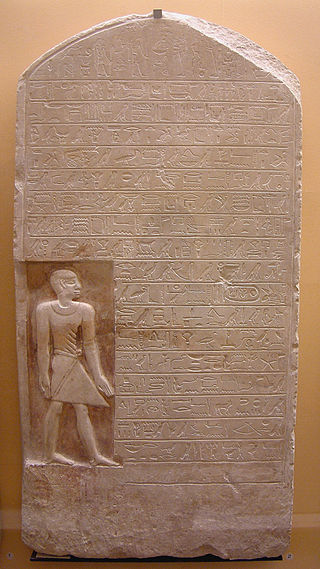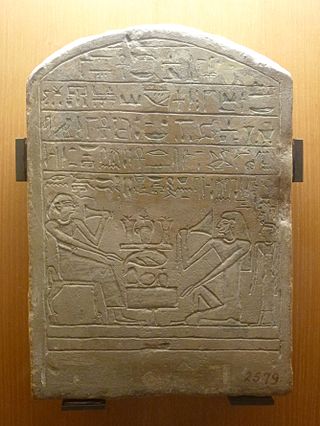
Tetisheri was the matriarch of the Egyptian royal family of the late 17th Dynasty and early 18th Dynasty.

Khasekhemre Neferhotep I was an Egyptian pharaoh of the mid Thirteenth Dynasty ruling in the second half of the 18th century BC during a time referred to as the late Middle Kingdom or early Second Intermediate Period, depending on the scholar. One of the best attested rulers of the 13th Dynasty, Neferhotep I reigned for 11 years.

Sekhemre Wahkhau Rahotep was an Egyptian pharaoh who reigned during the Second Intermediate Period, when Egypt was ruled by multiple kings. The Egyptologists Kim Ryholt and Darrell Baker believe that Rahotep was the first king of the 17th Dynasty.

Sekhemre Sewadjtawy Sobekhotep III was an Egyptian king of the mid Thirteenth Dynasty of Egypt who reigned three to four years.

Ankhu was an Egyptian vizier during the early 13th Dynasty in the late Middle Kingdom. He is believed to have resided in Thebes in Upper Egypt.

Senebsumai was an ancient Egyptian official of the early 13th Dynasty with the title high steward and later treasurer.

Iymeru Neferkare was the ancient Egyptian vizier under king Sobekhotep IV in the 13th Dynasty, in the Second Intermediate Period.

Senebi was an ancient Egyptian treasurer under the late 13th Dynasty kings Neferhotep I and Sobekhotep IV. Senebi belongs to the best attested officials of the 13th Dynasty.

Senewosret-Ankh {s-n-wsrt-ꜥnḫ/snfrw} was an ancient Egyptian vizier of the Middle Kingdom, dating to the end of the Twelfth or to the beginning of the Thirteenth Dynasty.
Nubemhat was an ancient Egyptian queen of the Second Intermediate Period.
Minemhat was an Ancient Egyptian mayor of Koptos during the 17th Dynasty in the late Second Intermediate Period. Minemhat appears in three sources and served during the reign of Nubkheperre Intef.

Menkhaure Snaaib was an Egyptian pharaoh during the Second Intermediate Period between the Middle Kingdom and New Kingdom at the end of the Middle Bronze Age.

Haankhef was the father of the ancient Egyptian kings Neferhotep I, Sihathor, and Sobekhotep IV, who successively ruled Egypt during the second half of the 18th century BC as kings of the 13th Dynasty.
Sobeknakht I was an ancient Egyptian official of the Second Intermediate Period. He was the local governor at Elkab.

Aabeni was an ancient Egyptian official with the title high steward. He was one of the most important officials at the royal court in the early Thirteenth Dynasty.

Hatshepsut was the name of one or several ancient Egyptian king's daughter(s) of the 13th Dynasty. There are three instances where a person named Hatshepsut is mentioned. It is not known if these items refer to the same or different individuals.

Nofret (Neferet) was an ancient Egyptian king's wife, most likely dated to the early Thirteenth Dynasty. She might have been the wife of king Ameny Qemau.
Rehuankh was an Ancient Egyptian high official associated with kings Neferhotep I and Sobekhotep IV of the Thirteenth Dynasty during the Middle Kingdom. Rehuankh is known from a high number of sources, making him one of the best attested officials of the late Middle Kingdom.
Senebsen was an Ancient Egyptian queen and wife of king Neferhotep I during the 13th Dynasty.

Amenyseneb was the Controller of a Phyle or Regulator of a Watch at Abydos during the early 13th Dynasty in the late Middle Kingdom of Egypt. While he was an official of lower rank, his attestations binds important persons like king Khendjer and vizier Ankhu in time.














